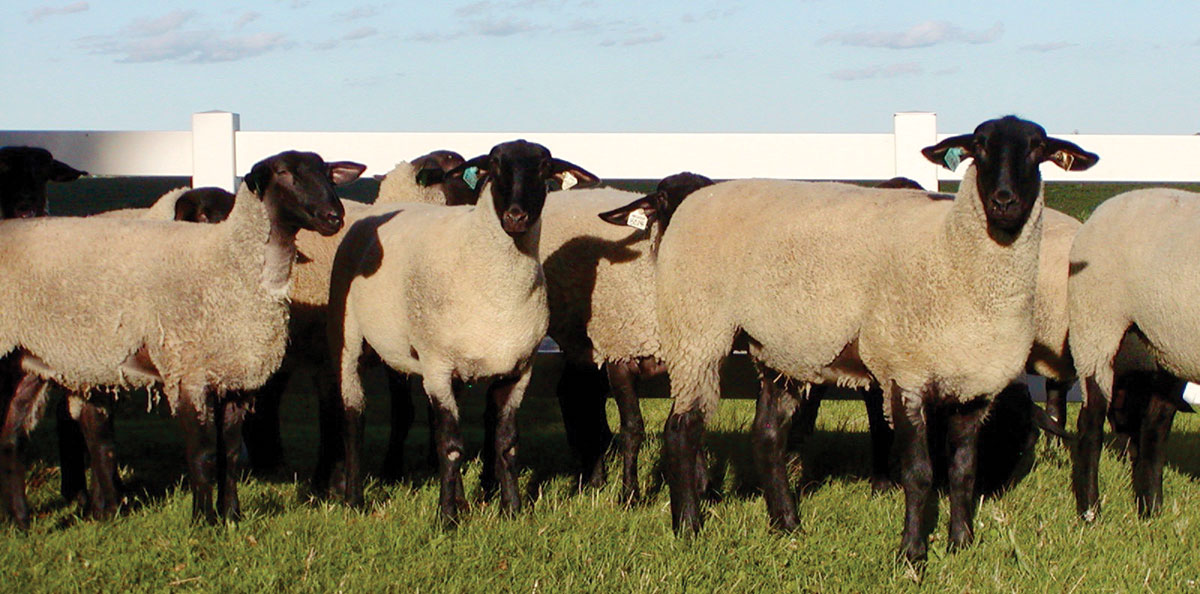
Bob Kimm brings his registered Suffolk operation to the Ozarks
Bob Kimm was an unlikely shepherd, but after more than 50 years in the industry, he is considered one of the premier breeders in the Suffolk industry.
Bob was a 2014 inductee of the United Suffolk Sheep Association Hall of Fame, is a well-respected judge and speaker, and a member of several Suffolk and sheep-related committees and organizations.
The native Iowan grew up on a cattle operation, but as he advanced in his career in agriculture education at Hawkeye Community College in Waterloo, Iowa, Bob became the beef and sheep specialist at the college in 1969. While there, a post he served at until his retirement in 2000, Bob began to appreciate the attributes of sheep, leading to the establishment of Kimm Suffolks.
“It’s hard to raise cattle on minimal acreage, so I decided to get sheep,” Bob, who moved to Willow Springs, Mo., in 2018, said. “I had cattle too, but in 1970 I got a small group of black-faced ewes and worked my way up. In 1971, I bought some purebred sheep and it got started from there.”
His roots in the cattle industry and career as an educator played a roll in the development of his flock. Kimm Suffolks’ motto is “The Home of Balanced Genetics.”
“I believe in records,” Bob explained. “The beef industry is very strong in EPDs, that’s why you have those numbers when you go buy breeding stock, so I tried to carry that same philosophy over to my sheep program when I started with Suffolks. I didn’t have the luxury of that information, but I soon found if I were to sell breeding stock, I would try to offer similar information to my customers that the cattle industry was doing; birthweights, weaning weights and I’d roll in whatever was available from the National Sheep Improvement Program, which allows you to get EPDs on sheep, so that’s what I did.”
The Suffolk breed is known for growth and carcass quality, attributes Bob appreciates and strives to follow. His goal is to breed complete sheep that are functional, productive, predictable, healthy and structurally correct, as well as having eye appeal.
“At one time, Suffolks were the most predominant breed in the world, but that kind of fell by the wayside,” Bob said. “I could have chosen a lot of different breeds, but I chose Suffolk; it’s my favorite breed.”
While Bob was still teaching in the animal science department, the Kimm flock grew to about 125 ewes.
It was Bob’s late wife of 47 years Barb, who prompted Bob to move from the college farm to his own.
“I had my sheep and cattle and the school and she said, ‘You’re never here, so if you’re going to do this, we need to have our own place,’” Bob recalled. “In 1974, we bought a place in Dysart and started to build it up.”
Part of building the Kimm reputation included hitting the road and participating in local, state and national shows, where Kimm Suffolks found a great deal of success.
“My son (Ted) and daughter (Flo) showed, mainly because dad wanted them to,” Bob said. “We would go to the national junior show and travel around; it was more or less our vacation. After they finished and went on to their careers, I had to decide what I was going to do. We were selling breeding stock all along, but I started an on-farm sale in 1987.”
The annual sale continues to draw buyers from around the county. The first Missouri sale was held in May 2019.
After losing Barb suddenly in 2013, Bob found love again and married Lu in 2015. The couple made their home in Iowa, but Lu, who spent a great deal of her life in North Carolina and Louisiana, missed the warmer days in the South.
“After we got married, she said, ‘You don’t want to live in Iowa for the rest of your life, do you?’ I told her I hadn’t planned on moving,” he recalled. “She said she would like to get closer to her daughter and grandkids in Louisiana. So we started looking at properties in Missouri and we ended up here in Willow Springs.”
Bob and Lu purchased 160 acres in Howell County, Mo., and reduced their flock, as well as dispersing three satellite flocks, two in Iowa and one in South Dakota, to about 40 brood ewes, all of which are from lines Bob has developed over his 50 years in the industry.
“Over the years, people have asked if I could identify the bloodlines that were the most impactful, and I can,” Bob said.
In addition to genetics, Bob said nutrition plays a pivotal role in the production of a high-quality animal. Moving from Iowa to Missouri, however, presented a few challenges for Bob and his flock.
“I saw all of this beautiful green grass,” Bob recalled. “We weren’t supposed to start lambing until January, then they started lambing in mid-December, about two to four weeks early. It was the mycotoxins in the fescue.”
Bob said he soon realized needed to supplement his ewes with grain and quality alfalfa in order to meet their needs.
“You have to have that premium forage,” he said, adding that he purchases hay from producers in West Plains and Cabool. “My feed bill is much higher here than it was in Iowa.”
Forages may have been an issue for the Kimms, but the milder winter has been a benefit. He no longer needs a totally enclosed lambing facility, but can an add windbreaks to his current three-sided barn, if needed, to protect young lambs, which typically are born in late October or early January.
After moving to the Ozarks, it was suggested Bob convert his production to haired breeds.
“A friend of mine said it would be like burning the church,” Bob said. “There would be a lot of people who would be very shocked if Bob Kimm switched to Dorpers or Kathadins.That’s not where my heart is. Suffolk is the breed I like and so I’m not going to change it now.”
After more than half a century in the registered sheep business, Bob hopes to continue his program as long as he can.
“There are days I question my sanity with having 40 ewes lambing,” he said. “I’m happy with between 35 and 40 brood ewes, and I don’t see any growth in that. I’ll be 77 in September and my wife has asked me how many years I’m going to keep doing this. I say I’m going to do it as long as I physically do so; it keeps me active.”







